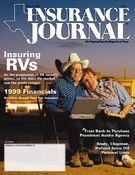The accusations are fierce, the stories heart-wrenching. Lost homes, marriages, fortunes and even lives are piling up on the doorstep of Lloyd’s of London, which has been accused for years of not disclosing potential huge losses from asbestos and pollution claims to newly recruited investors (Names). These allegations form the core of the fight now being waged on British turf in the case of Jaffray vs. Lloyd’s.
Now the battle is coming to the U.S. with what some say is a chance for success in the Names’ favor.
Bringing it back home
Jeffrey C. Peterson, executive director of the American Names Association (ANA), said this is the first time that investors have been able to have their allegations of fraud against Lloyd’s heard in any court, British or U.S. “That might seem amazing, but Lloyd’s has dodged all attempts to have allegations of fraud heard here,” Peterson said. “The case in England is making a concerted effort to imply that it’s the last case, the end-all, beat-all case that will determine whether Lloyd’s is fraudulent or not, but it’s not [the last case].”
Three separate cases are currently slated to take on Lloyd’s in the U.S. The major one is West vs. Lloyd’s and will potentially be heard late this year in Los Angeles Superior Court. There is a joint defense agreement between the West case and the Jaffray case in England, according to Peterson.
There is also a joint-defense agreement between Jaffray and the second case, Ables/Alff vs. LeBoeuf, Lamb, Green & MacRae, general counsel for Lloyd’s in the U.S., which could be heard in the spring of 2001 in L.A. Superior Court. The third case is Anthoine vs. Lord Bissell and Ann Brook et. al. The last two cases allege that the lawyers for Lloyd’s were acting as attorneys for the Names and for Lloyds’ simultaneously.
Lloyd’s continues to deny all allegations of fraud. Chairman Max Taylor stated his confidence in Lloyd’s imminent victory in the Jaffray case: “There’s nothing new in what [the Names] are saying. They’ve been making these allegations in public on and off for the last 10 years and have failed to substantiate any of them. This case is about the past. It’s not about Lloyd’s today, nor does it have implications for our business today. It’s true that the Lloyd’s market suffered major losses in the late ’80s and early ’90s, but 95 percent of the Names accepted a legal settlement to help them meet their losses.”
In 1982, Parliament passed the Lloyd’s Act, granting Lloyd’s self-regulatory status to police themselves as a private enterprise. The marketplace was granted immunity from nearly every kind of lawsuit except for fraudulent violations, meaning that plaintiffs must be able to prove that Lloyd’s defrauded with the intent to deceive, a difficult case to prove.
A “harrowing experience”
John H. Wiggins, of J.H. Wiggins Company in Redondo Beach, Calif., is a member of ANA with a story to tell. He became an investor in 1987, and began to lose money right away, as 1988 was the first big loss year for Lloyd’s. “I got in at the worst time,” he said. “I lost $1,050,000, and it has cost me well over a quarter million in legal and other fees attempting to recoup my losses and untold [amounts] in lost opportunities…It has been the most harrowing experience I’ve ever had in my life.”
Wiggins lost his home in Palos Verdes in 1995, his marriage suffered, and he eventually declared Chapter 11. Although he had assets to pay the liabilities, what he described as “the real albatross around all our necks” was the unknown contingencies.
“Contingencies are those liabilities that are lurking out there—they’re the old insurance policies that are not known at this time but may surface sometime within the next 20-30 years. The Lloyd’s contract goes beyond the grave. If I die, the liabilities carry over into my estate. A lot of people do not realize the onerous nature of the liabilities…The asbestos claims that are being made now are dipping into the third generation of the people who contracted asbestosis. It’s a world without end.”
What was the attraction and mystique of Lloyd’s that drew people to invest their life and soul in it? According to Lloyd’s Chairman Max Taylor, the Names enjoy “exploitation of Lloyd’s world-wide licenses, Lloyd’s brand name recognition, establishment of a niche or profit center outside the ‘corporate structure,’ access to the skills and experience of Lloyd’s underwriters, and a centralized market environment.”
Wiggins cited Lloyd’s “sterling reputation,” as well as the idea of “making your money work twice for you.” Lloyd’s allowed new Names to pledge their homes as collateral for the policies they underwrote and for which they were personally liable.
“You do not have to invest money in Lloyd’s, all you have to do is pledge,” Wiggins said. “Investing is writing a check, pledging is writing an IOU if they make a claim—that was the whole idea and the whole allure.”
Whatever it may have been, the allure was sufficient to capture the investment of close to 3,400 U.S. Names from 1972 to present. “Many of those people have died or settled,” Peterson said. “Californians were hit harder than anyone else in the whole world—the joke is that the further you were from London, the more money you lost.”
Adding up the losses
Lloyd’s three-year accounting cycle was part of the problem for the Names, as negative trends were slow to appear in writing. “This was very misleading…Nobody, not investors, insurance brokers or agents, knew what was really going on until the first big losses started to surface in 1991,” Peterson said. In this year, Lloyd’s announced losses of $800 million on the 1988 year of account.
Between 1988 and 1992, Lloyd’s lost $12.6 billion as a result of a series of both natural and man-made disasters, including major pollution incidents, European windstorms and U.S. asbestosis claims. Many Names were confronted with financial ruin. The hardship of some Names was such that about 30 individuals committed suicide rather than cope with their share of the losses.
Both Peterson and Wiggins are pessimistic about the outcome of the Jaffray case, but optimistic about the cases pending in U.S. Courts. “It makes a big difference whose turf you’re on,” Peterson said.
“I think the West case has a very good chance because it is going to be tested under U.S. law,” Wiggins said.
Peterson said the evidence is strong for the U.S. cases. “We uncovered all of the reports from Lloyd’s attorneys from the 1970s to 1995 that showed their tracking of all the asbestos-documents that are publicly available as evidence. There’s no shortage of evidence going in. What has been lacking is our chance for a day in court.”
It will not be an easy fight, by any means. “We’re fighting a battle against two governments as well as Lloyd’s, three Prime Ministers, Parliament, the Department of Trade and Industry and the Serious Fraud Office in London, as well as the English courts,” Wiggins said. “No court in the world would find anything against Lloyd’s. Lloyd’s is like the Queen.”
Whether its reign is over will become apparent in the coming year.
Topics USA Profit Loss Fraud Excess Surplus Lloyd's London
Was this article valuable?
Here are more articles you may enjoy.


 ‘Door Knocker’ Roofers Were Everywhere. NC Farm Bureau Saw an Opportunity
‘Door Knocker’ Roofers Were Everywhere. NC Farm Bureau Saw an Opportunity  Man Sentenced for Flashing Three Insurance Agencies in Georgia
Man Sentenced for Flashing Three Insurance Agencies in Georgia  Suit Against OpenAI and Microsoft Blames ChatGPT for Murder-Suicide
Suit Against OpenAI and Microsoft Blames ChatGPT for Murder-Suicide  State Insurance Legislators ‘Greatly Disturbed’ by Trump AI Regulation Order
State Insurance Legislators ‘Greatly Disturbed’ by Trump AI Regulation Order 


